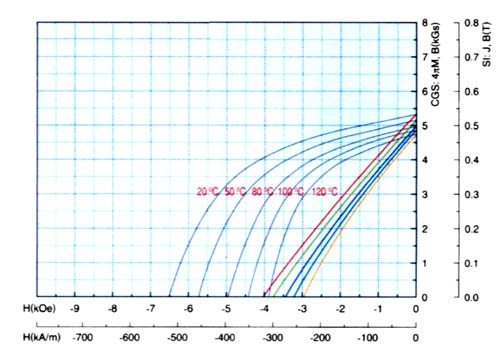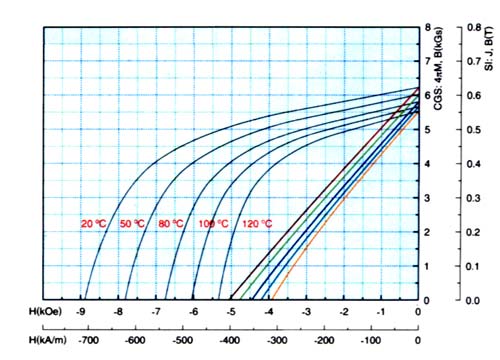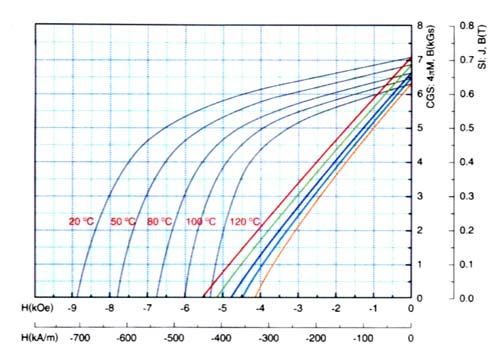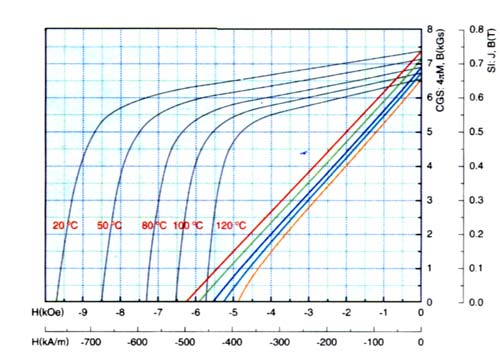Bonded NdFeB magnets are strong magnets which are used for various applications. They are manufactured by binding rapid-quenching NdFeB powde mixed with resin to form a magnet by compression molding with epoxy or infection molding with nylon. The latter technique is particular effective in large volume production, though the magnetic value of products is lower than those made with compression molding because of their relatively lower density. Bonded NdFeB is easily machined. Coolants must be used while machining this material in order to avoid spontaneous combustion of powder. Machining this material removes a layer of protective coating, and re-coating for corrosion resistance may be necessary. Various shapes of high dimensional accuracy can be produced without further processing. Epoxy coating is mostly common used for bonded NdFeB magnets, nickel-plating is also used to prevent corrosion.
Isotropic bonded NdFeB materials can be magnetized in any direction, or with multiple poles. Special magnetizing fixtures are required in order to achieve multiple pole magnetization. isotropic resin bonded Neodymium-Iron-Boron material offers a high energy product with an exceptional resistance to demagnetisation. Capable of operating up to 120ºC. Ring magnets may be machined from discs. Being isotropic, most shapes can be magnetised in any direction. Discs or rings may have either axial or diametric poles. Minimum field strength to magnetise to saturation is 3000kA/m (37500 0e). Such multipole fixtures may cost several thousands of dollars depending on design complexity and production rate requirements.
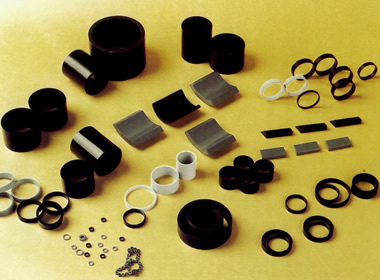
Other Properties of Bonded NdFeB Magnets
- Hybrid magnets to create different magnetic properties
- Characteristics for the initial magnetization of NdFeB bonded magnets
- Bonded Magnet Advantages
With different ratio of additives to NdFeB powder, magnetic properties of hybrid NdFeB magnets can be tuned in a wide range. Once the ratio is fixed, magnetic property fluctuation can still be limited in a narrow bank. Hybrid magnets will meet customers' specified properties.
Rapidly quenched NdFeB powder used for bonded magnets is multi grain with grain size of sub-micron. Powder is isotropic in magnetic properties, which results in flat increasing of remanence and intrinsic coercivity with applied field. Magnet can only be magnetized to saturation in high fields.
- Produced with high efficiency, stability and repeatability
- Magnet and other part may form together in one step
- Free choice of magnetizing direction-especially for multi-polar applications
- High dimensional accuracy-large quantity applications with minimum post-press machining
- Thin-wall ring and complex shape magnets
- High resistance to corrosion
Magnetic properties of bonded NdFeB Magnets
| P/N | Br Remanence |
Hcj Intrinsic Coercivity |
Hcb Coercive Force |
(BH)max. Maximum Energy Product |
||||
| MT | kG | kA/m | kOe | kA/m | kOe | KJ/m3 | MGOe | |
| NdFeB-NB6 | 440-560 | 4.40-5.60 | 560-680 | 7.0-8.5 | 240-320 | 3.0-4.0 | 32-48 | 4.0-6.0 |
| NdFeB-NB8 | 540-640 | 5.40-6.40 | 640-720 | 8.0-9.0 | 320-400 | 4.0-5.0 | 48-64 | 6.0-8.0 |
| NdFeB-NB8M | 540-620 | 5.40-6.20 | 1040-1360 | 13.0-17.0 | 384-464 | 4.8-5.8 | 56-72 | 7.0-9.0 |
| NdFeB-NB10 | 620-700 | 6.20-7.00 | 608-800 | 7.6-10.0 | 360-456 | 4.5-5.7 | 64-80 | 8.0-10.0 |
| NdFeB-NB12 | 690-760 | 6.90-7.60 | 640-840 | 8.0-10.5 | 400-480 | 5.0-6.0 | 80-96 | 10.0-12.0 |
Physical Chracteristics of bonded NdFeB Magnets
| P/N | µrec Recoil Permeability |
Hs Magnetizing Field |
Density | Temperature Coefficient | Tc Curie Temperature |
K[2] Ring Crushing Strength |
Coefficient of Thermal Expansion (25-200°C) |
||
| µrec | kA/m | g/cm3 | kOe | α (Br) %/°C |
β (Hcj) %/°C |
°C | kg/mm2 | 10-6/°C | |
| NdFeB-NB6 | 1.22 | 1600 | 5.1-5.6 | 20 | -0.14 | -0.40 | 360 | 5.5 | 4.8 |
| NdFeB-NB8 | 1.22 | 1600 | 5.4-5.8 | 20 | -0.13 | -0.40 | 360 | 5.5 | 4.8 |
| NdFeB-NB8M | 1.18 | 2000 | 5.8-6.0 | 25 | -0.12 | -0.38 | 305 | 5.5 | 4.8 |
| NdFeB-NB10 | 1.22 | 1600 | 5.8-6.0 | 20 | -0.11 | -0.40 | 360 | 5.5 | 4.8 |
| NdFeB-NB12 | 1.17 | 1600 | 5.9-6.1 | 20 | -0.11 | -0.41 | 360 | 5.5 | 4.8 |
Note:
[1] The properties given above are typical at room temperature(23°C) for uncoated samples.
[2] Ring Crushing Strength K is defined as follows, with the force applying along a diameter of magnet ring and P is the value at which the first crack appears. K=P(D-T)/LT2
K—Ring Crushing Strength(kg/mm2), P—Load on magnet ring(kg), D—Outer diameter(mm),
T—Ring thickness(mm), L—Height of the ring(mm)
Safety Notes for the Application and Storage of Bonded Magnets
- Do not place magnets near person wearing electrical medical equipment, such as pacemaker, because the magnet may result in malfunction of the equipment and endanger person's life
- Keep magnets away from magnetic memory media or other magnetic field sensitive devices such as magnetic cards, tapes, floppy disks, hard disk drivers and watches. Otherwise information stored in the media or the devices may be damaged
- Big block of magnet will strongly attract each other or attract iron steel pieces,which may cause serious injure to person
- Relatively weak in strength,bonded magnets may break into pieces when collide with other materials.Be careful in assembling magnets and prevent the finy fragments from entering into eyes or cause other injuries
- Keep magnets in good condition and avoid following environment in case that magnets become rust or weaken in mechanical or magnetic strength
- With acid, alkali, organic solvent or electrolytes
- Immersed in water or in oil
- Space filled with hydrogen
- Space filled with corrosive gases such as Cl2, NH3, Nox, etc.
- With radioactive rays




